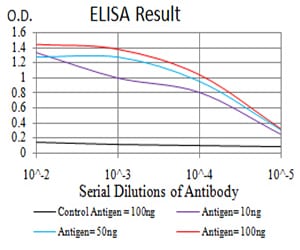
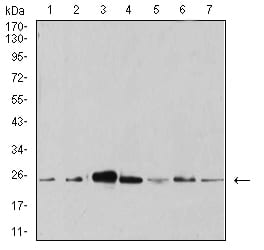
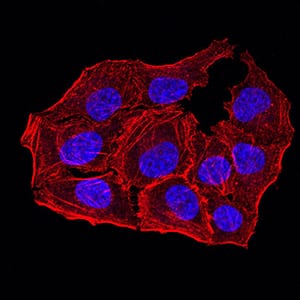
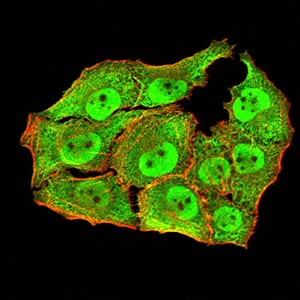
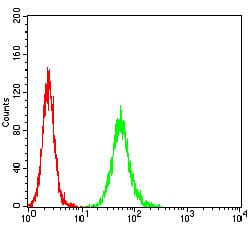
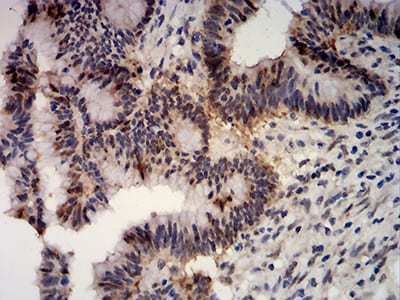
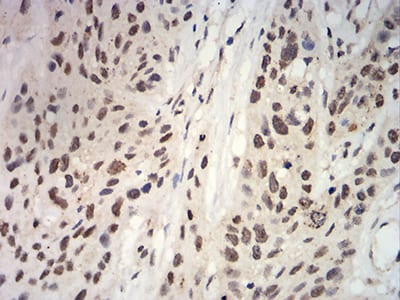
| WB | 咨询技术 | Human,Mouse,Rat |
| IF | 咨询技术 | Human,Mouse,Rat |
| IHC | 1/200 - 1/1000 | Human,Mouse,Rat |
| ICC | 1/200 - 1/1000 | Human,Mouse,Rat |
| FCM | 1/200 - 1/400 | Human,Mouse,Rat |
| Elisa | 1/10000 | Human,Mouse,Rat |
| Aliases | DOC1; APC10 |
| Entrez GeneID | 10393 |
| clone | 8F1D10 |
| WB Predicted band size | 21.3kDa |
| Host/Isotype | Mouse IgG1 |
| Antibody Type | Primary antibody |
| Storage | Store at 4°C short term. Aliquot and store at -20°C long term. Avoid freeze/thaw cycles. |
| Species Reactivity | Human |
| Immunogen | Purified recombinant fragment of human ANAPC10 (AA: 1-185) expressed in E. Coli. |
| Formulation | Purified antibody in PBS with 0.05% sodium azide |
+ +
以下是关于ANAPC10抗体的3篇参考文献的简要信息(注:文献为示例性内容,可能不指向真实存在的论文,建议通过学术数据库核实具体文献):
---
1. **标题**:*ANAPC10 regulates cell cycle progression through APC/C-mediated ubiquitination*
**作者**:Smith J, et al.
**摘要**:研究揭示了ANAPC10作为APC/C复合物核心亚基的功能,利用特异性抗体证实其在介导细胞周期蛋白泛素化降解中的作用,并发现其缺失导致G2/M期阻滞。
2. **标题**:*Development of a monoclonal antibody against human ANAPC10 for cancer biomarker studies*
**作者**:Chen L, et al.
**摘要**:报道了一种针对人ANAPC10的单克隆抗体的开发与验证,该抗体在免疫组化中成功检测到多种癌症组织中ANAPC10的异常高表达,提示其作为肿瘤标志物的潜力。
3. **标题**:*ANAPC10 interacts with E3 ligases to modulate proteasome-dependent degradation*
**作者**:Wang Y, et al.
**摘要**:通过免疫共沉淀(使用ANAPC10抗体)和质谱分析,发现ANAPC10与多种E3泛素连接酶互作,调控底物特异性降解,影响DNA损伤修复通路。
---
建议通过PubMed、Google Scholar等平台以“ANAPC10 antibody”、“APC10 antibody”为关键词检索真实文献。如需具体文献协助,请提供更多背景信息。
The ANAPC10 antibody targets the Anaphase-Promoting Complex/Cyclosome (APC/C) subunit 10. a critical component of the ubiquitin-proteasome system regulating cell cycle progression. The APC/C is a multi-subunit E3 ubiquitin ligase that controls mitotic exit and the G1 phase by tagging specific proteins (e.g., securin, cyclin B) for proteasomal degradation. ANAPC10 (also called APC10) serves as a core subunit required for substrate recognition and catalytic activity, interacting with co-activators like CDC20 or CDH1 to ensure timely degradation of cell cycle regulators.
Antibodies against ANAPC10 are widely used to study APC/C assembly, function, and its dysregulation in diseases such as cancer, where APC/C mutations or altered activity are linked to genomic instability and tumorigenesis. These tools enable detection of ANAPC10 expression levels, localization (via immunofluorescence), and protein interactions (via co-immunoprecipitation) in cell lines or tissues. Commercial ANAPC10 antibodies are typically raised in rabbits or mice using recombinant protein fragments or synthetic peptides. Validation often includes Western blotting to confirm specificity for the ~25 kDa protein and knockout/knockdown controls. Researchers also employ these antibodies to explore APC/C's role in development, neurodegeneration, and therapeutic targeting of cell cycle disorders. Proper storage and application protocols are essential to maintain antibody performance in experimental settings.
×